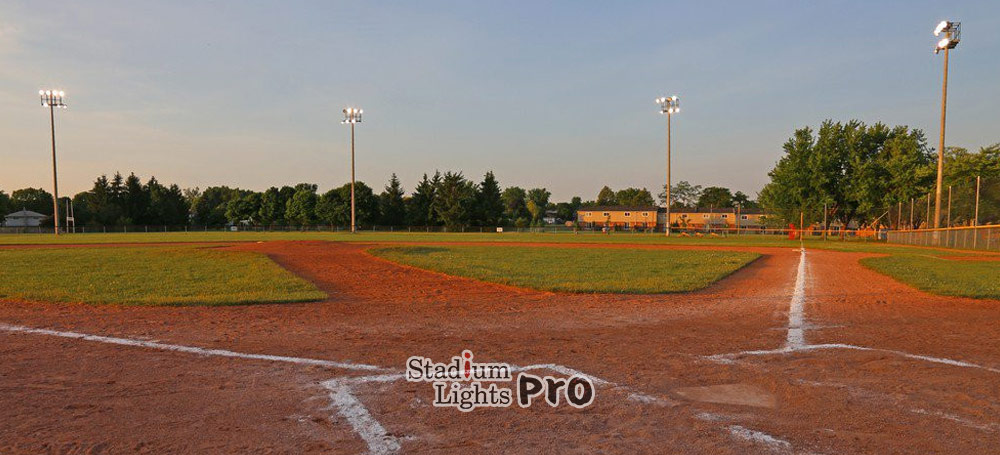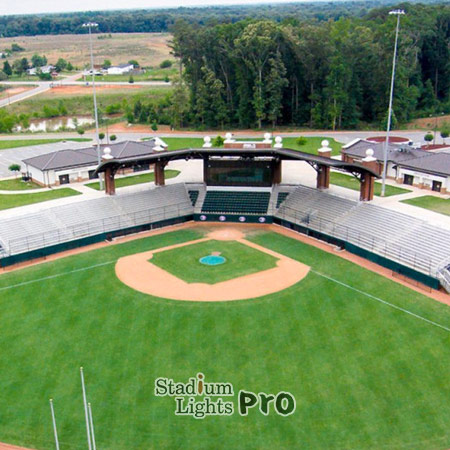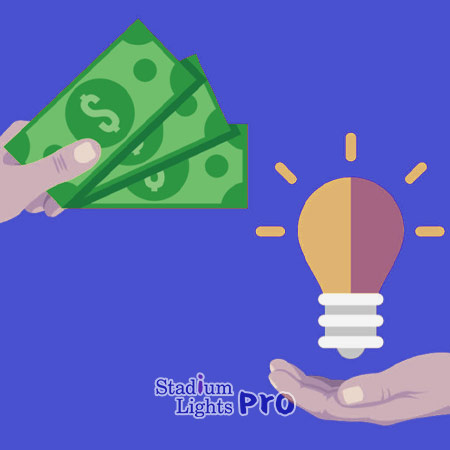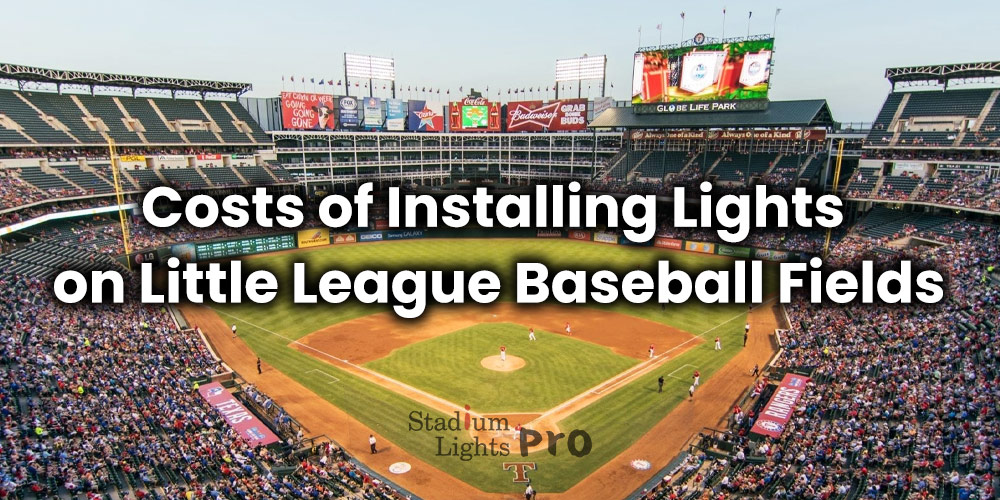Table of Contents
ToggleWhy should we consider the cost of lighting for a Little League baseball stadium?
- Budgeting – Knowing the cost of lighting the Little League baseball field is crucial for budgeting and financial planning. It will help the league understand how much funding is needed and where to allocate resources.
- Funding – Understanding the cost of lighting is essential for obtaining funding for the project. This will help the league to develop a realistic budget and funding proposal.
- Planning – Knowing the cost of lighting will determine the overall scope of the project and for making informed decisions about what type of lights to use and how to design the lighting system.
- Feasibility – By understanding the cost of the project, the league can determine the feasibility of installing lights on the field and whether it is within their financial capabilities.
- Comparison – Knowing the cost of lighting is also crucial for comparison purposes. By obtaining estimates from different providers, the league can compare the costs and benefits of different lighting options. This can help to ensure that they are getting the best value for their money.
Estimating the cost of lighting a Little League baseball field

How much does Little League lighting cost?
Calculating the cost of lighting a Little League baseball field can be a complex process that involves several variables. However, for the purpose of this example, we will make some assumptions to provide a rough estimate of the cost.
Assumptions
| Field size | The field is a standard Little League baseball field, with dimensions of 60 feet between bases and 46 feet from the pitcher’s plate to home plate, and an outfield fence of 200 feet. |
| Type of lights | The lights used are LED lights |
| Number of lights | 20 lights will be installed around the field |
| Installation cost | $1,500 for installation labor and materials |
| Electrician cost | $3,000 for running the power to the lights |
| Local permits and building codes | $1,000 |
| Life expectancy of the lights | 100,000 hours |
| Energy cost | $0.12 per KWH |
| Usage | Field will be used 2 hours per day, 5 days per week, 50 weeks per year. |
Calculation breakdown
| Cost of lights | $20,000 (20 lights x $1,000 per light) |
| Installation cost | $1,500 |
| Electrician cost | $3,000 |
| Local permits and building codes | $1,000 |
| Total cost | $25,500 |
| Energy cost | $1,440 (2 hours x 5 days x 50 weeks x 12 KWH x $0.12 per KWH) |
| Total cost for first year | $26,940 |
| Maintenance cost | A rough estimate of maintenance cost could be 1% of the cost of the lights per year, considering a regular maintenance schedule, in this case it would be $200 per year |
| Total cost for the first 5 years | $29,940 |
| Total cost for the life expectancy of the lights | $59,940 |
Before calculating the cost of Little League baseball lighting
Taking accurate measurements of the field
 Accurately measuring the size of the field, including the distance between bases and the distance from the pitcher’s plate to home plate, is essential for determining the number and placement of lights required.
Accurately measuring the size of the field, including the distance between bases and the distance from the pitcher’s plate to home plate, is essential for determining the number and placement of lights required.
Considering local regulations and building codes
Local regulations and building codes can affect the cost of the project by dictating the type of lights that can be used, the height of the poles, and the distance between poles. Therefore, it’s highly recommended to consult with the local authorities to obtain information about the regulations and building codes in the area, and to factor these into the estimates.
Researching different lighting options
Researching different lighting options, including different types of lights and different manufacturers, can help to ensure that the estimates take into account the most recent and cost-effective options available in the market.
Gathering information about the field’s usage
We need to gather information about the field’s usage, how many hours per week, how many games per year, this information will help to determine how much light is needed and how often the lights will be used, which can affect the overall cost of the project.
Getting multiple estimates
Getting multiple estimates from different lighting providers can help to ensure that the estimates are accurate by comparing different costs for the same project and identifying any potential cost overruns.
How to estimate the cost of lighting a Little League baseball field?
Online cost calculators
There are several online cost calculators available that can provide estimates for the cost of lighting a field based on certain inputs, such as the type of lights used, the size of the field, and the location of the field. However, it’s essential to keep in mind that these estimates are only rough approximations and may not take into account all of the variables that can affect the cost of the project.
Consulting with lighting professionals
Consulting with lighting professionals such as lighting engineers or lighting designers can provide a more accurate estimate of the cost of lighting a field. They will be able to take into account the specific requirements of the project, such as the field layout, the weather conditions and the local building codes and permits. They can also recommend the best lighting options to meet the budget and goals of the project.
Comparing quotes
Contacting multiple lighting providers and requesting quotes can help to compare the costs of different lighting options. This can help to ensure that the league is getting the best value for their money, and can provide an idea of the cost of the project
Researching similar projects
Researching similar projects, such as other baseball fields in the area, can help to give an idea of the cost of lighting a Little League baseball field. This can provide insight into the costs of different types of lights, installation, and maintenance.
Funding options for lighting Little League baseball fields
Funding options for lighting Little League baseball fields
Grants
 Many foundations, organizations and government agencies offer grants to help fund Little League baseball field lighting projects. These grants can be based on need, merit or specific characteristics of the community or project.
Many foundations, organizations and government agencies offer grants to help fund Little League baseball field lighting projects. These grants can be based on need, merit or specific characteristics of the community or project.
Loans
Banks, credit unions, and non-profit organizations offer loans specifically for community projects like Little League baseball fields. These loans can have favorable terms and interest rates.
Fundraising campaigns
Communities can also raise funds through various fundraising campaigns such as crowdfunding, community events, and donations. This allows people to contribute to the project and feel invested in the outcome.
Sponsorships
Some organizations, businesses and philanthropic individuals may be willing to sponsor the project with financial contributions in exchange for advertisement opportunities or other benefits.
In-kind donations
Companies that provide construction materials, supplies, and labor at a reduced cost or for free can also help to reduce the overall cost of the project.
Community Investment
Communities can set up a fund or special assessments for the local residents for long-term projects like this one, which can provide a steady stream of income over the years
Suggested reading: Financing options for building a baseball field
How to identify and apply for funding opportunities?
Identifying and applying for funding opportunities for lighting Little League baseball fields can be a complex process. However, there are several steps that can be taken to increase the chances of success, including:
Research funding opportunities
Research the different types of funding opportunities available, such as grants, loans, fundraising campaigns, and sponsorships. Look for opportunities that align with the goals and needs of the project, and that have a good track record of funding similar projects.
Build a strong team
A strong team of volunteers or staff who are committed to the project can help to increase the chances of success. This team can include people with experience in fundraising, grant writing, and community outreach.
Develop a clear and compelling proposal
A clear and compelling proposal that outlines the need for the project, the benefits of the project, the budget and timeline, and the plan for implementation and evaluation is crucial for success. A well-written proposal that highlights the potential impact of the project on the community can increase the chances of obtaining funding.
Identify potential partners
Identifying potential partners such as local businesses, foundations, and government agencies can increase the chances of success. Partners can provide funding, in-kind donations, and other resources to support the project.
Tailor the proposal for each opportunity
Each funding opportunity may have its own specific requirements, so be sure to tailor the proposal to the specific funding source, highlighting how the proposal aligns with the funding source’s goals, and address the requirements.
Follow-up
Following up with the funding source after submitting the proposal can help to ensure that the proposal has been received and to address any questions or concerns.
Factors affecting the cost of lighting a Little League baseball field
What lights are used in Little League baseball field?
The type of lights used can have a significant impact on the cost of the project. For example, LED lights tend to be more energy-efficient and longer-lasting than traditional HID lights, but they may be more expensive initially.
Metal Halide (MH) lights
MH lights are a type of High-Intensity Discharge (HID) light that are commonly used in sports fields. They produce bright white light and have a long lifespan. However, they can be relatively expensive to operate and maintain.
High-Pressure Sodium (HPS) lights
HPS lights are another type of HID light that are also commonly used in sports fields. They produce a yellow-orange light and are relatively inexpensive to operate, but they have a shorter lifespan than MH lights.
Light-Emitting Diodes (LED) lights
LED lights are becoming more popular in sports fields because they are energy-efficient and have a long lifespan. They also produce bright, white light and are relatively low-maintenance.
Fluorescent lights
Fluorescent lights are less common in sports fields but used in smaller fields or indoor facilities. They are relatively inexpensive and energy-efficient, but they have a shorter lifespan and lower light output than HID or LED lights.
How big is a Little League baseball field?
The size of the field will also impact the cost of the project. A larger field will require more lights and will therefore be more expensive to light.
The size of a Little League baseball field can vary depending on the age group of the players and the level of play. However, the standard size for a Little League baseball field is as follows:
Little League baseball field (ages 11-12)
The field dimensions are 60 feet between bases and 46 feet from the pitcher’s plate to home plate. The outfield fence ranges from 200-230 feet, this distance is known as “base paths”
Junior League baseball field (ages 13-14)
The field dimensions are 70 feet between bases and 50 feet from the pitcher’s plate to home plate. The outfield fence ranges from 225-300 feet.
Senior League baseball field (ages 15-16)
The field dimensions are 90 feet between bases and 60 feet 6 inches from the pitcher’s plate to home plate. The outfield fence ranges from 300-325 feet.
It’s worth noting that these are general guidelines and the dimensions of the field may vary depending on the availability of land and local rules. Also, fields for Little League softball have different dimensions, with a shorter distance between bases (60 feet) and a shorter distance from the pitcher’s plate to home plate (40 feet)
How does the location of a Little League ballpark affect the cost of lighting?
The location of the field can also affect the cost of the project. If the field is in a remote area, the cost of running power to the lights may be higher than if the field is located near existing power sources.
Access to power
If the field is located in a remote area, the cost of running power to the lights may be higher than if the field is located near existing power sources. This can increase the cost of the project by adding additional materials and labor expenses.
Climate
The climate in the area can also affect the cost of lighting. For example, in areas with extreme temperatures, extra cooling or heating measures may be required for the lights, increasing the cost of the project.
Building codes and permits
Different locations may have different building codes and permitting requirements for lighting projects. These regulations can vary by city, state, or even by country, and may require additional design, engineering, and compliance efforts and therefore, additional cost.
Installation
The location of the field may also affect the cost of installation. For example, if the field is located on a steep incline or in an area with limited access, it may be more difficult and costly to install the lights.
Maintenance
The location of the field can also affect the cost of maintenance. If the field is located in a remote area, it may be more difficult and costly to access the lights for maintenance, which can increase the overall cost of the project over time.
How does the quality of the lights affect the cost?
The quality of the lights used can affect the cost of the project. High-quality lights may have a higher initial cost but they can last longer, require less maintenance and be more energy efficient.
Initial cost
High-quality lights may have a higher initial cost than lower-quality lights. The cost may vary based on the brand and the manufacturer, but higher-quality lights will likely be more expensive.
Energy efficiency
High-quality lights are generally more energy-efficient, which can help to lower the long-term cost of the project by reducing electricity consumption and associated costs.
Life-Span
High-quality lights tend to have a longer lifespan than lower-quality lights, which means that they will need to be replaced less frequently. This can help to lower the overall cost of the project over time by reducing the need for frequent maintenance and replacements.
Maintenance
High-quality lights may require less maintenance than lower-quality lights. This means that the cost of maintenance will be lower over the life of the lights, which can help to lower the overall cost of the project.
Reliability
High-quality lights tend to be more reliable and less prone to failure than lower-quality lights, which can help to ensure that the field is properly lit at all times and avoid costly repairs or replacements.
Permits and building codes
The cost of permits and compliance with local building codes can also add additional expenses to the project. We need to research about building codes and permits requirements for the area and add them to the budget.
LED vs HID lighting cost
There are several trade-offs to consider when choosing between different types of lights for a Little League baseball field, such as LED vs HID (High-Intensity Discharge) lights.
- LED lights tend to be more energy-efficient than HID lights. They use less power to produce the same amount of light, which can help to lower the long-term cost of the project by reducing electricity consumption and associated costs.
- LED lights also have a longer lifespan than HID lights. They typically last for 50,000-100,000 hours, while HID lights typically last for around 20,000-24,000 hours. This means that LED lights will need to be replaced less frequently, which can help to lower the overall cost of the project over time.
- HID lights, however, tend to be cheaper than LED lights initially, specially the High-Pressure Sodium lights. The upfront cost of HID lights is generally lower than that of LED lights, which can make them more attractive from a cost perspective, especially for small budget projects.
- LED lights produce a higher quality of light than HID lights. They tend to be brighter and produce a more consistent light, which can improve visibility and safety on the field.
- HID lights require more maintenance than LED lights. They tend to require frequent bulb replacements, and their ballasts (the electrical component that regulates the current in the lamp) need to be replaced occasionally.
Conclusion
Determining the number of lights needed to properly light a baseball field involves several factors such as field size, illumination level, type of lights, number of poles and etc.
At StadiumLightsPro, we understand the importance of proper lighting for Little League baseball fields, not only to extend the playing time but also to increase safety for the players. That’s why we offer a free lighting consultation service for baseball fields, to help you determine the best lighting solutions to meet your specific needs and budget.
Our team of lighting professionals can provide you with expert advice on the most cost-effective options available in the market and create a customized plan that addresses your specific goals and requirements.
Our cost estimation service will provide you with accurate and detailed estimates of the cost of lighting your field, taking into account factors such as the type of lights used, the size of the field, and the location of the field. Please don’t hesitate to contact us for more information on how we can assist you with your Little League baseball field lighting project.

